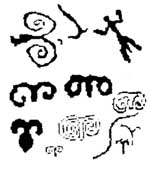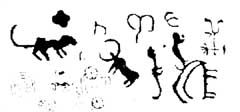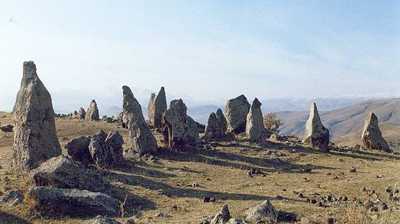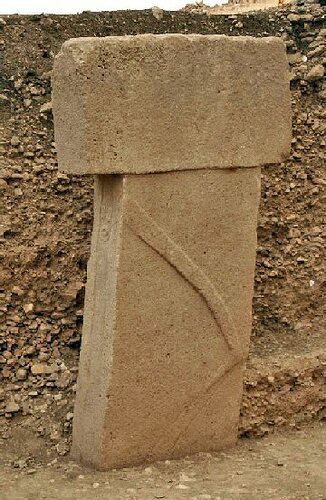List members , this well researched article emphatically proves the widespread , persistent beliefs about THE most enigmatic star - Sirius , in ancient cultures right across the globe...does mankind share a direct , organic link with a planet in the Sirius star system ?? Hmm...food for thought :-
Sirius the most important star – worshiped at Karahundj Armenia’s Stone Circle
Stone symbol carvings discovered on a megalithic stone circle in Metsamor, Armenia:


Source: Images and text from “Karahundj Armenia’s Stonehenge” excerpted below
“It should be no surprise to anyone who knows something of Armenia’s history that astronomy is such an important part of the national character. Sun symbols, signs of the zodiac, and ancient calendars predominated in the region while the rest of the world was just coming alive, culturally speaking. Egypt and China were still untamed wilderness areas when the first cosmic symbols began appearing on the side of the Geghama Mountain Range around 7000 BC.
At Metsamor (ca 5000 BC), one of the oldest observatories in the world can be found. It sits on the southern edge of the excavated city, a promontory of red volcanic rocks that juts out like the mast of a great ship into the heavens. Between 2800 and 2500 BCE at least three observatory platforms were carved from the rocks.
The Metsamor observatory is an open book of ancient astronomy and sacred geometry. For the average visitor the carvings are indecipherable messages. With Elma Parsamian, the first to unlock the secrets of the Metsamor observatory as a guide, the world of the first astronomers comes alive.

“The Metsamorians were a trade culture,” Parsamian explains. “For trade, you have to have astronomy, to know how to navigate.”
The numerous inscriptions found at Metsamor puzzled excavators, as indecipherable as they were elaborate. Hundreds of small circular bowls were carved on the rock surfaces, connected by thin troughs or indented lines. But one stood out. It is an odd shaped design that was a mystery to the excavators of the site, until Professor Parsamian discovered it was a key component to the large observatory complex.
By taking a modern compass and placing it on the carving, Parsamian found that it pointed due North, South and East. It was one of the first compasses used in Ancient times. Another carving on the platforms shows four stars inside a trapezium.
The imaginary end point of a line dissecting the trapezium matches the location of star which gave rise to Egyptian, Babylonian and ancient Armenian religious worship. Sketch the locations of the Jupiter moons over several nights and you’re repeating an experiment Galileo did in 1610.
Chart a star over several years and you repeat an experiment the Metsamorians did almost 5000 years ago. By using the trapezium carving and a 5000 year stellar calendar, Parsamian discovered that the primary star which matched the coordinates of its end point was the star Sirius, the brightest star in our galaxy.
Worship of Sirius “Sirius is most probably the star worshipped by the ancient inhabitants of Metsamor,” Parsamian explains. “Between 2800-2600 BCE Sirius could have been observed from Metsamor in the rising rays of the sun. It is possible that, like the ancient Egyptians, the inhabitants of Metsamor related the first appearance of Sirius with the opening of the year.”…
The Metsamorians also left behind a calendar divided into twelve months, and made allowances for the leap year. Like the Egyptian calendar which had 365 days, every four years the Metsamorians had to shift Sirius’ rising from one day of the month to the next. “There is so much I found in 1966,” Parsamian adds, “and so much we do not know. We believe they worshipped the star Sirius, but how? I like to imagine there was a procession of people holding lights.
These carved holes throughout the complex may have been filled with oil and lit. Just imagine what it must have looked like with all those little fires going all over the steps of the observatory. Like a little constellation down on earth.”
Parsamian has a special regard for Metsamor, since it was she who uncovered many of the mysteries of the inscriptions on the observatory, answers which explained other finds uncovered at the excavation site.”When you walk over this ancient place, you can use your imagination to complete the picture. I love to visit Metsamor since I feel I am returning to the ancients.””
Was the Armenian worship of the Sirius, the origin of a body of astronomical knowledge that would diffuse to throughout the Middle East, Egypt-Greece and beyond?
In Egypt: Sirius was known in ancient Egypt as Sopdet (Greek: Sothis) as the “Dog Star”, reflecting its prominence in its constellation, Canis Major (Greater Dog), and is recorded in the earliest astronomical records. During the era of the Middle Kingdom, Egyptians based their calendar on the heliacal rising of Sirius – the day it becomes visible just before sunrise after moving far enough away from the glare of the Sun. It marked the annual flooding of the Nile and the summer solstice, after a 70-day absence from the skies. The hieroglyph for Sothis features a star and a triangle. Sothis was identified with the great goddess Isis, who formed a part of a triad with her husband Osiris and their son Horus, while the 70-day period symbolised the passing of Isis and Osiris through the duat (Egyptian underworld). A similar association is depicted at the Temple of Hathor in Dendera, where the goddess Satet has drawn her arrow at Hathor (Sirius).
More than 8 million mummified dogs and jackals were reported to have been found at the Dog Catacombs at Saqqara, the burial ground for the ancient capital Memphis.
“Our findings indicate a rather different view of the relationship between people and the animals they worshipped than that normally associated with the ancient Egyptians, since many animals were killed and mummified when only a matter of hours or days old,” Nicholson said. “These animals were not strictly ‘sacrificial.’ Rather, the dedication of an animal mummy was regarded as a pious act, with the animal acting as intermediary between the donor and the gods.”
In the Arab-African sphere Sirius was well known to the Arabs: Ibn Kathir said in his commentary “Ibn ‘Abbas, Mujahid, Qatada and Ibn Zayd said about Ash-Shi`ra that it is the bright star, named Mirzam Al-Jawza’ (Sirius), which a group of Arabs used to worship. Sirius is mentioned in Surah, An-Najm (“The Star”), of the Qur’an, and called al-shi’raa…and in verse (An-Najm:49) “That He is the Lord of Sirius (the Mighty Star).” The Dogon people are an ethnic group in Mali, West Africa, reported to have traditional astronomical knowledge about Sirius and a third star accompanying Sirius A and B (and given treatment in Robert Temple’s 1976 book The Sirius Mystery). In the religion of the Serer people of Senegal, the Gambia and Mauritania, Sirius is called Yoonir from the Serer language (and some of the Cangin language speakers, who are all ethnically Serers). The star Sirius is one of the most important and sacred stars in Serer religious cosmology and symbolism…astronomical knowledge perhaps learned in ancient times from the Moors with whom they traded extensively. The Serer high priests and priestesses, (Saltigues, the hereditary “rain priests”) chart Yoonir in order to forcast rain fall and enable Serer farmers to start planting seeds. In Serer religious cosmology, it is the symbol of the universe  Yoonir, Symbol of the Universe
Yoonir, Symbol of the Universe
In Iranian-Scythian-Indo-Aryan-Caucasus mythological sphere, especially in Persian mythology and in Zoroastrianism, the ancient religion of Persia, Sirius appears as Tishtrya and is revered as a divinity. Beside passages in the sacred texts of the Avesta, the Avestan language Tishtrya followed by the version Tir in Middle and New Persian is also depicted in the Persian epic Shahnameh of Ferdowsi (“Tir”, the star was portrayed as the arrow in later Persian culture). Due to the concept of the yazatas, powers which are “worthy of worship”, Tishtrya is a divinity of rain and fertility and an antagonist of apaosha, the demon of drought. In this struggle, Tishtrya is beautifully depicted as a white horse…which may behind the sacrifice of white horses all over the Steppes, India and East Asia.
In the Greek-Bactrian-Roman spheres: Sirius appears to have signaled ill-portent. Depicted classically as Orion’s dog, the Ancient Greeks thought that Sirius could put dogs at the risk of disease and dehydration, making them behave abnormally during the “dog days,” the hottest days of the summer. The Romans knew these days as dies caniculares, and the star Sirius was called Canicula, “little dog.” The excessive panting of dogs in hot weather was thought to place them at risk of desiccation and disease. Homer, in the Iliad, describes the approach of Achilles toward Troy in these words:
Sirius rises late in the dark, liquid sky /On summer nights, star of stars, /Orion’s Dog they call it, /brightest Of all, /but an evil portent, bringing heat /And fevers to suffering humanity
The Latin name Sīrius, originates from from the Ancient Greek Σείριος (Seirios, “glowing” or “scorcher”), although the Greek word itself is thought to have been imported from elsewhere, it is suggested, from associations with the Egyptian god Osiris
The East Asian sphere appears to have been influenced directly either by the Persian and/or Bactrian ideas of Sirius as the celestial dog. In Chinese astronomy the star is known as the star of the “celestial wolf” (both Chinese and Japanese: 天狼 Tiānláng; Japanese romanization: Tenrō; and found in the Mansion of Jǐng (井宿) in ancient Chinese astronomical charts which also had a large bow and arrow across the southern sky, formed by the constellations of Puppis and Canis Major, with the arrow tip pointed at the wolf Sirius.
For the Polynesians it marked winter and was an important star for navigation around the Pacific Ocean.
Genetic research has established the origins of the New World indigenous inhabitants to be in the region of the Altai, the Inner Mongolia and Northern China. Thus it is no longer a stretch to deduce a connection in the oral and astronomical traditions … many nations among the indigenous peoples of North America also associated Sirius with canines: the Seri and Tohono O’odham of the southwest note the star as a dog that follows mountain sheep, while the Blackfoot called it “Dog-face”. The Pawnee of Nebraska had several associations; the Wolf (Skidi) tribe knew it as the “Wolf Star”, while other branches knew it as the “Coyote Star”. Further north, the Alaskan Inuit of the Bering Strait called it “Moon Dog”.
The Cherokee paired Sirius with Antares as a dog-star guardian of either end of the “Path of Souls”. This recalls the East Asia-Middle East wide practice of having dog/wolf/lion guardian statues on either side of tombs and temples. Meanwhile to the Polynesians Sirius marked winter and was an important star for navigation around the Pacific Ocean.
Origins
Astrology is an occult practice that originated in ancient Mesopotamia, Egypt, India and China.
The astrologers observed the movements of the planets and assigned them godlike features and powers. Each planet represented a god or a goddess and ruled certain areas of life. The astrologers advised the rulers/kings and interpreted the pattern of planetary movements as omens or signs for understanding the future. The practice is deeply rooted in the concept of Divination an important aspect of the Mesopotamian life. Divination was employed as a technique to communicate with gods, who according to the Mesopotamian religious thought, shaped the destinies of humans and controlled all events in the cosmos.
According to John Rogers, most of the zodiacal signs originated in Mesopotamia, spreading quickly through Egypt and the Middle East, while another set of maritime signs likely originated in the Mediterranean, in Minoan Crete.
Hellenistic Egypt systematized the omen materials of the earlier Babylonian astrologers. Many astrological techniques, such as the use of 12 houses, lots and aspects were developed at this time and spread throughout the area by the Greek writers. By the 2nd century BC, the Greek scientist Hipparchus developed the mathematical astronomy that was given its final form by Ptolemy in the 2nd century AD. Ptolemy’s work in turn influenced all astrological/astronomical works until the advent of new sciences, including the Islamic celestial concepts and astronomical studies of the Middle Ages. The time of the Persian dominion, particularly from the last quarter of the fifth century BC until the Greek conquest, was the most creative period for Babylonian mathematical astronomy. Astronomical schools existed in Uruk, Sippar, Babylon and Borsippa. The Achæmenians maintained an atmosphere favourable to the development of science. Under Darius a great Babylonian astronomer, Nabu-rimanni (Naburianus), was instructed to carry out a study of lunar eclipses and arrived at calculations more accurate than those of Ptolemy and Copernicus. His works were translated and used for many centuries by all, including the Seleucid and Parthian rulers of Persia. His picture of the Heavens was borrowed by the Greeks and eventually reached the famous Greek scientist, Democritus. The terminology employed by Naburianus includes spheres, orbits, ecliptic, inclination, celestial equator, poles, circular motion, revolutions, retrogression, moon’s highest north and south latitudes. All these terms were used extensively by the Greek astronomers, including the brilliant Eudoxus of Cnidus, precursor of Euclid. Another well-known Babylonian astronomer under the Persian rule, Kidinnu (Cidenas) of Sippar, distinguished the solar year from the lunar, discovered the precession of the equinoxes. Astrological history was important to Sassanian Imperial ideology. The stars decreed the fate of the mortals and the kings expected to receive special protection. Shahnameh is full of stories where the fate of the heroes is sealed in the astronomical charts read at the time of their birth. Ptolemy and Greek astronomy were very well known in Iran. To what extent astronomy was separated from astrology is not clear and very likely astrology would have dominated the field. The Muslim Arabs destroyed almost all of the literature of the Zoroastrian Sassanians, including their astrological works. However there are some clues as to what their astrology might have been. Most of the greatest astrologers in the Islamic era were Persians! The astrology Iranians taught is quite different from both the Hindu and the Greek traditions. It had orbs of aspect, the Great Cycles of Jupiter and Saturn, all of the elaborate systems of planetary interactions such as Frustration, Abscission of Light, Translation of Light and so forth. While Muslim-era astrology owes a large debt to Hellenistic astrology, it is also clear that in the two or three centuries between the last known Hellenistic astrologers and the first known Muslim ones, something new had come into the field. This was very likely the Persian stream of astrology.
Alternative theories suggest Armenia as originators. Rogers also suggests that the synthesis of some of the constellations (Taurus, Scorpius, Leo, Canis minor, Perseus) may have taken place in the melting pot region of Cilicia (Anatolia, Asia Minor), where the Mithraic cult originated with the pirates of the Middle East. Several constellations are known universally by all ancient cultures, these include the Plough/Great Spirit Bear/Big Dipper, Pleiades and Orion. Stephen Oppenheimer and Robert Schoch hypothesize that the maritime Austronesians(aka Sundalanders radiating outwards to the Middle East and elsewhere), Austro-Asiatics respectively, may have been the originators or spreaders of those. Around 1000 BC the astronomical knowledge of the Babylonians was passed on to the Greeks, who identified 48 constellations. earliest references to astronomy are found in the Rig Veda, which are dated 2000 BC. Indian astronomical references of chronological significance may be found in the Vedas with notices marking the beginning of the year and that of the vernal equinox in Orion (around 4500 BC). Fire altars, with astronomical basis, have been found in the third millennium cities of India. The texts that describe their designs are conservatively dated to the first millennium BC, but their contents appear to be much older.
Hellenistic astrology is a complex tradition of horoscopic astrology that appeared in the Mediterranean region sometime around the 1st century BCE, and was practiced until approximately the 7th century CE. It is the ancestor of many of the modern traditions of astrology that still flourish around the world today.
This tradition has its roots in ancient Egypt and Mesopotamia, and it influenced many other subsequent traditions of astrology across Europe, Africa, the Middle East and India during the middle ages and through to modern times.
Hellenistic astrology is a complex tradition of horoscopic astrology that appeared in the Mediterranean region sometime around the 1st century BCE, and was practiced until approximately the 7th century CE. It is the ancestor of many of the modern traditions of astrology that still flourish around the world today.
This tradition has its roots in ancient Egypt and Mesopotamia, and it influenced many other subsequent traditions of astrology across Europe, Africa, the Middle East and India during the middle ages and through to modern times.
Sources and references:
Egyptian “Dog Catacomb” has 8 million mummified dogs by Hellum, PearsonLloyd, Gareth Neal Donna Wilson, Woodgate etc
Karahundj, Armenia’s Stonehenge by Rick Ney
Origin of the ancient constellations II. Mediterranean traditions by John H. Rogers
Out of Eden by Stephen Oppenheimer
Voyages of the Pyramid Builders: The True Origins of the Pyramids from Lost Egypt to Ancient America, 2003 by Robert M. Schoch
Timeline of Ancient Astrologers
Additional notes below:
 The most repetitive symbol appears to be that of Aries (solar symbol, also associated with Mars and spring represented by the glyph of the horns of a ram) while the second symbol depicted clockwise from the top left … appears to be similar to the one found at Gobekli Tepe (below)
The most repetitive symbol appears to be that of Aries (solar symbol, also associated with Mars and spring represented by the glyph of the horns of a ram) while the second symbol depicted clockwise from the top left … appears to be similar to the one found at Gobekli Tepe (below)
Modern astrological symbols:  aries
aries taurus
taurus gemini
gemini cancer
cancer leo
leo virgo
virgo  libra
libra scorpio
scorpio sagittarius
sagittarius capricorn
capricorn aquarius
aquarius pisces
pisces
Regards

